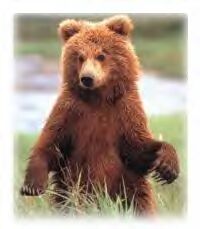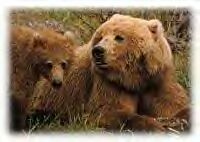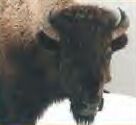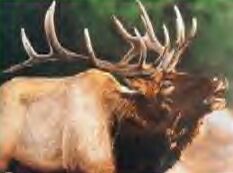|
OVERVIEW
HISTORY
ACTORS
MAPS
DIMENSIONS:
STUDY
TEAM
REFERENCES
|
Ecosystem Effects on Grizzly
Feeding Subsistence
.Protection of existing grizzly bear habitat, restoration of
grizzly bear habitat, and linking grizzly bear ecosystems to
each other are keys to the long-term survival of the the grizzly
bear. Some of the threats to grizzly bear habitat in the Yellowstone
Grizzly Bear Ecosystem include: forest service and other roads,
logging, oil and gas development, development of private lands
(for more information on land development click here),
introduction of exotic species, global warming and the continued
availability of reliable long-term grizzly bear food sources
in protected habitat. This page will look at feeding subsistence
and concerns involving the grizzlies four main food sources--foods
such as whitebark pine nuts, army cutworm moths, ungulate meat
(particularly bison) and cutthroat trout, which are the Yellowstone
Grizzlies mainstay.
SEASONAL FEEDING REGIMES
Spring
From March through May, ungulates,
mostly bison and elk, are a substantial part of a grizzly bear’s
diet. Grizzly bears feed on ungulates primarily as winter-killed
carrion but also through predation on elk calves. Other items eaten
during spring include grasses and sedges, dandelion, clover, spring-beauty,
horsetail, and ants. Grizzly bears also feed extensively on whitebark
pine nuts stored in red squirrel caches, especially during springs
when an abundance of pine nuts have been left over from the previous
fall (Mattson and Jonkel 1990).
Summer
Form June through August, grizzly bears
continue to consume grasses and sedges, dandelion, clover, spring-beauty,
whitebark pine nuts, horsetail, and ants. In addition, thistle,
biscuitroot, fireweed, and moths are eaten, Predation on elk calves
continues until late-June/early-July when grizzly bears are no longer
able to catch calves (Gunther and Renkin 1990). In areas surrounding
Yellowstone Lake, bears feed extensively on spawning cutthroat trout
(Reinhart 1990). Starting around midsummer, grizzly bears begin
feeding on strawberry, globe huckleberry, grouse whortleberry, and
buffaloberry. By late summer, bistort and yampa are included in
the diet, and grasses, sedges, and dandelion become less prominent.
Fall
From September through October, whitebark
pine nuts are the most important bear food. Other items consumed
during fall include: grasses and sedges, bistort, yampa strawberry,
globe huckleberry, grouse whortleberry, buffaloberry, clover, horsetail,
dandelion, ungulates, ants and moths.
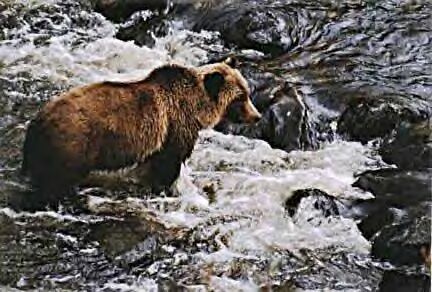 |
Grizzly subsistence
relies mostly on 4 Food items -Trout, Pine Nuts, Moths &
Ungulates.
According to grizzly feeding subsistence
research within the Yellowstone ecosystem, 80 to 90% of
the grizzly’s main energy needs relies upon the combination
of trout, pine nuts, moths, and ungulate meat (Mattson,
1984, 1988 and 1990’). Unfortunately, ecosystem changes
are negatively effecting all four of these food sources
(this griz could be waiting for a cutthroat trout that never
comes - click below under the fish and find out more?)
|
|
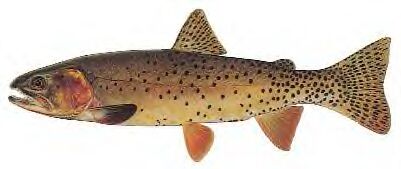
More
Trout Information
|
Grizzlies need
the Yellowstone Cutthroat Trout
Presently, illegal introduction
of exotic lake trout in Yellowstone Lake threaten the indigenous
population of cutthroat trout that many bears feast upon
during the spring spawn. The lake trout, which out-compete
the cutthroat, live to deeply in the water to be a replacement
food source for most bird and mammal species . In addition
to the Grizzly many other animals depend on the Cutthroat
trout including otters, eagles, kingfishers and ospreys.
(Schullery, 1996)
|
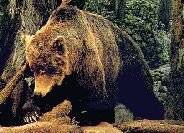 |
Grizzlies
and Whitebark Pine nuts
Whitebark Pine
nuts are a high-nutrition food that many grizzlies seek
out in the autumn before their winter slumber. Unfortunately,
this food source had declined by 25% in Yellowstone Park
after the 1988 Yellowstone forest fires. And even though
whitebark pine may reestablish on sites burned by fire,
production of a substantial number of cones is not expected
for a century (Matson and Reinhart, 1994). Whitebark Pines
are also threatened by the emergence of an arboreal disease
known as blister rust. This alien fungus has destroyed whitebark
pine stands in northwest Montana and is now infecting more
and more trees in the Yellowstone region (Matson and Pease,
1999)..
|
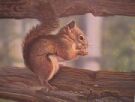 |
The Red
Squirrel provide nut caches for bears
Most whitebark
pine cone crops are dependent on the harvesting by red squirrels
who cut the cones down and bury them in mounds of forest
litter called middens, or a cache. Because whitebark pine
cones do not fall off the tree or drop their seeds the year
they ripen and grizzly bears cannot climb trees, grizzlies
must rob squirrel middens to feed on the seeds (Matson and
Reinhart, 1997).
|
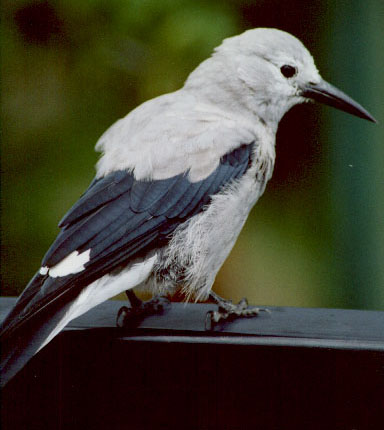 |
Clark's
Nutcrackers are important!
These birds
play a central role in the dispersal of Whitebark Pine (Hutchins
and Lanner 1983). Thanks to the Johnny Appleseed-like habits,
new whitebark pines can eventually grow from the thousands
of seeds these birds bury and leave behind. Unfortunately,
the spread of blister rust is threatening the Yellowstone
Whitebark and it is feared that the nutcracker will not
stick around as nut crops fail. Instead they will move to
lower elevations where the smaller seeds of other pines
can support them, but in fewer numbers. Fewer birds to disperse
seeds means less regrowth in high-elevation clearings, a
lowered tree line, and ultimately less food and habitat
for nutcrackers, squirrels, and bears (Baskin 1998).
|
|
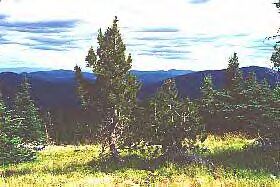 More
Whitebark Pine Information
More
Whitebark Pine Information
|
The
critical role of whitebark pine!
Following
bumper whitebark cone crop years, pine nuts can dominate
the food habits of bears for the entire next year. Both
grizzlies and black bears alike eat whitebark pine seeds
whenever they are available. In average crop years, bears
feed on them from mid-August too late fall. Following years
of bumper crops, many cones remain in squirrel caches the
nest spring. When this happens, bears begin to feed on pine
nuts as soon as they emerge from their winter dens and are
capable of locating and excavating cone caches under at
least 6 feet of snow(Kendall, 1983). Unfortunately, researchers
have estimated that during poor whitebark pine nut production,
grizzly bear deaths have increased by nearly 50% as bears
leave the mountains for populated areas in search of supplemental
food (Mattson & Reinhart 1997). In addition, besides
the loss of trees from the growing blister rust epidemic,
studies also suggest that global climate change may shrink
the habitat available for whitebark pine and it is feared
that virtually all-available whitebark habitat could be
lost within Yellowstone.
|
|
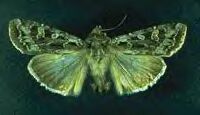
More
Moth Information
|
Yellowstone
Grizzlies will gorge on Army Cutworm Moths
Recent bear research documented
that bears in the Greater Yellowstone and Glacier Ecosystems
feed on army cutworm moths. From entomological studies,
it was known that these moths migrate in early summer form
the Great Plains to spend the summer in the Rocky Mountains..
In Yellowstone NP, army cutworm moths spend their days resting
in the cool spaces between jumbled rocks in talus fields
near the tops of some of Yellowstone’s highest peaks. The
moths emerge at night to feed on nearby flower nectar. Research
on bear use of moths and the alpine ecology of army cutworm
moths estimated the nutritional importance of this diet
item; during peak feeding periods when moths are abundant,
bears eat approx. 40,000 moths/day. This high nutrition
food lures bears into the relative safety of the high country,
miles from the nearest humans. These insects, however, are
vulnerable to pesticide spraying in the valleys below, as
well as to the loss to global warming of their own tundra
food sources – wildflower nectar. In addition, grizzlies
feeding on moths are disturbed by recreational mountain
climbing -
Link
to recreation site containing more on the disruption of
moth feeding
|
|
|
|
Grizzly dependence
on ungulates:
Studies by Mattson and Charles
Robbins at Washington State University show that Yellowstone
grizzlies represent one of the most meat-dependant bear
populations in North America. Carcasses of winter-killed
bison and elk have been an important source of protein for
grizzlies just emerging from their dens in the spring. But
those carcasses could become fewer as the government reduces
and tightly regulates park bison and free-ranging elk herds
to reduce the possibility of wildlife spreading the disease
known as brucellosis to domestic cattle outside the park.
Agencies are even discussing management schemes for bison
that would cap their numbers at about half of what they
were during the late 1980’s and early 1990’s
|
|

More
Wolf information
|
Wolves,
Ungulates and Grizzly interactions
According to researchers in
the Yellowstone region - who after wolf reintroduction are
gaining new insights into carnivore roles - wolves are good
engineers of biodiversity and most meat eaters actually
gain from having them around (cougars and coyotes being
the exception). Wolf kills can mean more food for grizzlies
(and eagles, ravens and other scavengers). Some researchers
witnessing new grizzly- wolf interactions are not quite
ready to say that wolves benefit grizzlies but believe at
the very worst the grizzly is neither helped nor harmed.
For example, sometimes bears chase wolves off kills and
other times wolves chase grizzlies, and deaths have occured
on both sides." See link "When
carnivores clash " for more information.
|
|
